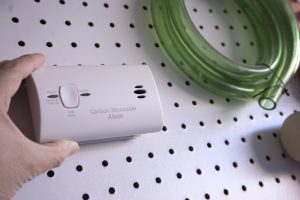 When you picture the job description of a heating technician, you probably consider that the primary job responsibilities are to know how to install and repair a furnace or AC system. But our training goes beyond this in some important ways. Heating technicians also function as safety advocates and preventative maintenance techs. And carbon monoxide (CO) is one of the biggest concerns of any HVAC technician.
When you picture the job description of a heating technician, you probably consider that the primary job responsibilities are to know how to install and repair a furnace or AC system. But our training goes beyond this in some important ways. Heating technicians also function as safety advocates and preventative maintenance techs. And carbon monoxide (CO) is one of the biggest concerns of any HVAC technician.
It’s a tough topic to tackle, but we want to make sure you know how to prevent a CO leak, how to detect one, and why it’s so important to schedule routine furnace service. Contact us today for more information.
What Is Carbon Monoxide?
Carbon monoxide is an odorless, colorless, poisonous gas that is produced during fuel combustion. Let’s break that statement down a bit.
Unlike natural gas, which produces a smell of rotten eggs (something added into the gas by the utility company), you won’t be able to smell a carbon monoxide leak. You cannot see it either. Unfortunately, many people don’t find out that a carbon monoxide leak has occurred until they start getting sick. And, unfortunately, deaths can occur.
The gas is produced during fuel combustion, meaning it is made as you use your oven, furnace, or even a dryer. However, all of these natural gas systems have vents that lead to the outside of the home. Carbon monoxide, along with other combustion byproducts, should vent straight to the outdoors.
How Would Carbon Monoxide Leak into a Home?
Carbon monoxide is first produced in the heat exchanger (the metal component where heat transfers to air as it passes by). Then, it moves out to the flue vent. So there are a couple of things that may be wrong if carbon monoxide is leaking into the home at the furnace.
- A crack in the heat exchanger, which becomes more likely the longer you go without heating maintenance.
- Breakage or cracks along the flue vent. Some vents also use fans to move byproducts outdoors, so a broken vent fan could contribute as well.
How Can I Prevent a CO Leak?
You can prevent a carbon monoxide leak by scheduling regular inspections for your furnace. A complete furnace tune-up once a year allows a technician to check for potential CO leaks and other risks, like fire hazards and gas leaks. It also may include a complete heating system tune-up, depending on the contractor and the service you schedule, which can help you save money on energy and fuel bills!
Where Should I Have CO Detectors?
Even if you are diligent about routine heating system maintenance, it’s so important to have carbon monoxide detectors in place. Carbon monoxide detector regulation is a recent event in building codes, and some older homes still are not required to have them throughout the house. Regardless of local codes multiple CO detectors are a must have.
We recommend having carbon monoxide detectors in or near every room of the home where someone sleeps, and one within 10 feet of the main living area. Check local codes for additional requirements in your area.
Inspect your heating system in Colorado Springs, CO with the help of the pros at Robbins Heating & Air Conditioning.
